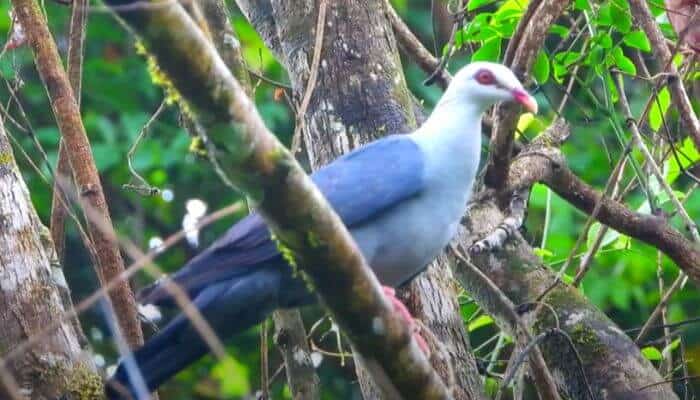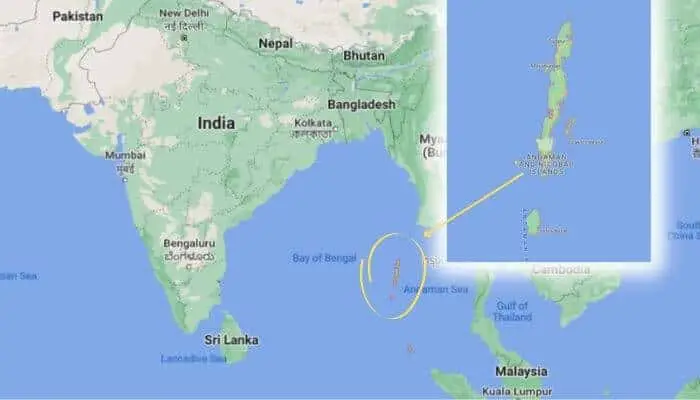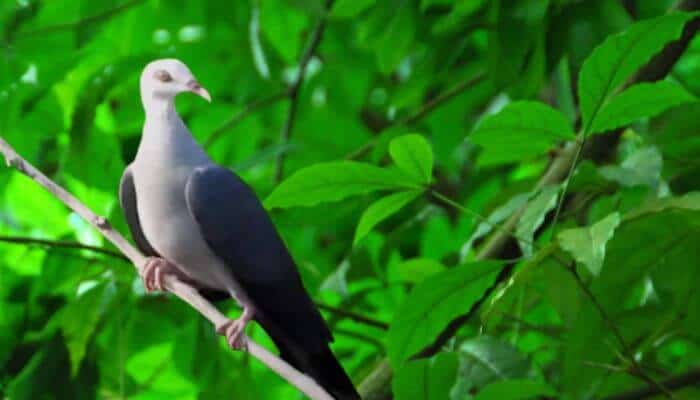The Andaman Wood Pigeon is a wild fruit-eating pigeon found only in the Andaman and Nicobar Islands (India).
This large, grey-colored pigeon lives in dense evergreen forest and is listed as Near Threatened on the IUCN Red List.

The Andaman Wood Pigeon is the State bird of Andaman Islands and is one of five bird species endemic to both the Andaman and Nicobar islands (home of the Nicobar pigeon).
The Andaman Wood Pigeon (Columba palumboides) looks similar to a rock pigeon and is closely related to the Ashy Wood Pigeon (Columba pulchricollis) and the Metallic Pigeon (Columba vitiensis).
Origins of the Andaman Wood Pigeon
Andaman Wood Pigeons are part of the “Columba” genus and the “Columbidae” family.
The Columba Genus comprises medium to large pigeons and includes 33-35 species.
These pigeons are one of five species endemic to the Andaman and Nicobar islands.

There is another pigeon species endemic to the islands, the Andaman Green Pigeon (Treron chloropterus).
You can find the Andaman Wood Pigeon in the dense forests of the islands. They do not migrate although they do move between the Andaman islands in search of ripe fruit.
The first description of the Andaman Wood Pigeon was written in 1873 by Allan Hume in the Stray Feathers: Journal of Ornithology for India and its Dependencies.
Distribution & Habitat of the Andaman Wood Pigeon
The Andaman Wood Pigeon lives exclusively in the trees and is found in dense broadleaved evergreen forest.
Due to this pigeon’s high dependency on dense forests, they have limited available habitat and are at risk of becoming endangered due to habitat loss.
Andaman Wood Pigeons are distributed over an estimated area of 31,544.5 square miles; this is quite a small occurrence area for an entire species.
Although these pigeons are mostly found in the broadleaved forest, they can sometimes be found in tropical and subtropical lowland forest areas too.
Andaman Wood Pigeon Appearance
| Wingspan | Length | Weight | Coloring | |
|---|---|---|---|---|
| Andaman Wood Pigeon | Unknown | 35 – 40cm | 517g | Dark, slate grey and light silvery grey |
| Average Feral Pigeon | 64 – 72 cm | 32 – 37 cm | 300 – 500 g | Bluish grey with some black |
The Andaman Wood Pigeon resembles a rock pigeon although it has a longer tail.
This fruit-eating pigeon is easily identified by their grey coloring and red-based, yellow-tipped bill.

The Andaman Wood Pigeon is not all one tone of grey, these birds have dark grey wings, a much paler grey (almost white) head and a silvery grey neck.
They also have bare red skin around the eyes and pink feet.
In the right light, these large pigeons have a slight green iridescence around the base of their neck and a purple iridescence elsewhere.
The Andaman Wood Pigeon is similar in size to the Green Imperial Pigeon but has different coloring.
The grey vents and the bare red skin around the eyes of the Andaman are the easiest way to tell it apart from the Green Imperial.
Facts About The Andaman Wood Pigeon
- The Andaman Wood Pigeon is the Andaman Islands’ State Bird
- This pigeon is endemic to the Andaman and Nicobar Islands
- The Andaman Wood Pigeon is closely related to the Ashy Wood Pigeon and the Metallic Pigeon
- The Andaman Wood Pigeon population is declining due to habitat fragmentation and deforestation
- This is a non-migratory bird species
Andaman Wood Pigeon Conservation
The Andaman Wood Pigeon is listed as near threatened on the IUCN Red List with the most recent assessment in 2017.
There are believed to be between 2,500 – 9,999 adult Andaman Wood Pigeons left in the wild.
Unfortunately, there is limited data available on this species. Surveys in 1996 and 2007 have found the Andaman Wood Pigeon to be relatively rare.
The good news is that independent sightings of the Andaman Wood Pigeon are reported on eBird relatively regularly, along with photos and audio recordings.
However, their population is thought to be decreasing and is potentially fragmented due to hunting and habitat degradation.
The key causes of the population decline are hunting and logging in the dense forest the Andaman Wood Pigeon relies on. Habitat loss and fragmentation are also on the rise due to the increased pressure put on the forest by the rising human population on the islands.
At the moment conservation efforts around the Andaman Wood Pigeon are limited. The Zoological Survey of India is monitoring the population of bird species in Andaman & Nicobar to help determine how best to prevent the species from becoming endangered and extinct.
To help conserve the Andaman Wood Pigeon, it is proposed that further research is done to find out more about the ecology and population size of the species.
Regular monitoring is also suggested to determine population trends and investigate how the pigeon reacts to forest degradation and hunting.
Andaman Wood Pigeon Character
The Andaman Wood Pigeon is a shy and inconspicuous bird.
As this bird lives in the trees in dense forest they are rarely observed and, as a result, very little is known about their behaviour and character.
Although it is hard to spot these pigeons, they do make their presence known thanks to their distinctive hooting call. The Andaman Wood Pigeon’s call is a deep “whoom” sound.
Diet
Andaman Wood Pigeons are frugivorous so they only eat fruit. Their diet consists of a wide variety of fruit and berries.
Andaman Wood Pigeons love to eat figs, berries and small fruit.
These pigeons have been known to move between islands in search of fruiting fig trees and other food sources.
Mating And Breeding Andaman Wood Pigeons
There is still a lot to learn about Andaman Wood Pigeons, their behaviour, and ecology. At the moment, little is known about the breeding behaviour of these pigeons.
It is thought Andaman Wood Pigeons live in pairs or small groups but there is no available information regarding mating or breeding season.
It is known that Andaman Wood Pigeons live for 5-6 years. They lay eggs but their nests have not been documented so their breeding season, the number of eggs they lay, and the appearance of the juveniles is not yet known.
Caring for Andaman Wood Pigeons
The Andaman Wood Pigeon is a wild species that is not suitable for living in domestic environments or for being kept as a pet.
There are none of these pigeons in captivity and the best way to help care for these birds is to support conservation efforts and the protection of their habitat.
As the Andaman Wood Pigeon is currently considered “Near Threatened” and their population is declining, the species is at risk of becoming endangered if their habitat is not protected.
